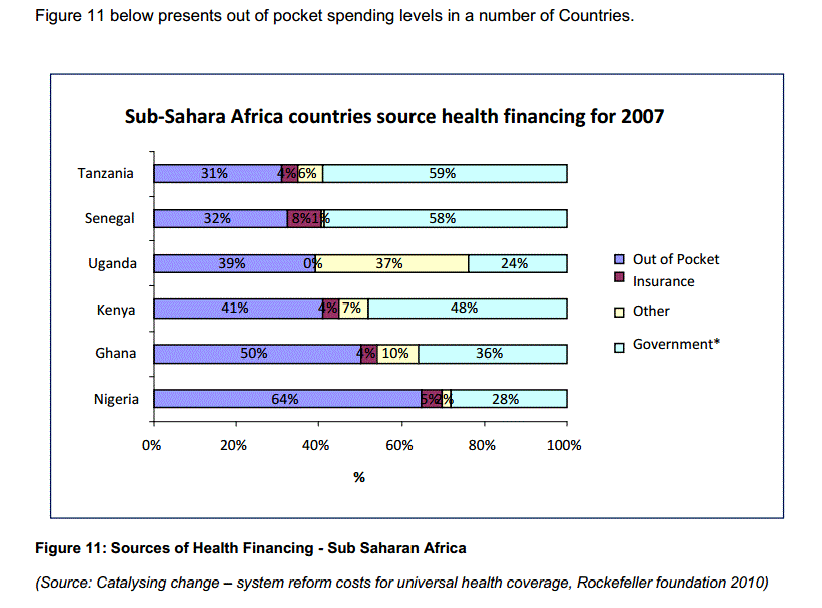Medical Inflation! hits Family Budgets
The following articles were published in Business Daily Africa. We've opted to post the article without any alterations, so as to give you ample time to brace for higher Medical / Health Cover Premiums.
We have linked various good articles giving explanations as to why operating costs such as staff costs and electricity have necessitated these adjustments. All this, as Kenya slips down the competitive index to 120 out-of 144 nations.
The rising cost of locally produced generic drugs and, imposition of Value-Added Tax on local pharmaceutical manufacturers will eventually result in medical costs, even within the NHIF scheme, being expensive.
The adoption of your Family's Health History and Experience being used to calculate Health Insurance Premiums is likely to impact further on Households, notwithstanding the inelastic rise in Household Incomes.
Medical Inflation, like fuel and electricity, is not included in the Inflation calculations used by the Central Bank of Kenya. There is no "Medical Cost Inflation Index" for Medical Cost Inflation vis-a-vis Overall/Underlying Inflation.
"Private hospitals up fees by up to 50% in eight months"
Source: Business Daily Africa,
By David Herbling and Victor Juma
Posted Monday, September 8 2014 at 20:30
Kenya’s leading private hospitals have increased their consultation charges by up to 50 per cent, prompting insurers to raise premiums for medical cover and pushing the cost of healthcare beyond the reach of more consumers.
Other charges have also risen due to value added tax (VAT) payments and staff costs for the increased charges.
Nairobi’s Karen Hospital and Aga Khan University Hospital, and the Mombasa-based Pandya Hospital are among the top health facilities that have raised outpatient consultation fees, hitting underwriters and direct customers hard.
With 83 per cent of Kenyans living on less than $2 (Sh175) a day, few can afford to pay out of pocket for services at a private hospital. Only about a quarter of Kenyans have medical cover, according to a report by consulting firm Deloitte prepared for the restructuring of the National Hospital Insurance Fund (NHIF).
Link: NHIF Strategic Review & Market Assessment of Pre-Paid Health Schemes by Deloitte
http://p4h-network.net/wp-content/uploads/2013/10/NHIF-Strategic-Review-Deloitte-Final-Report_Oct-26-2011.pdf
The increases have set the stage for an overall rise in hospital charges that insurers say has become an annual or biannual affair. Gertrude’s Children Hospital, for instance, last month raised various charges for the third time since January last year.
Hospital administrators say the increases are meant to cover ballooning staff and supplies costs, and a general rise in the cost of living. Without the revised charges, they argue, they would not be able to retain highly qualified medical staff.
The resultant medical inflation means Kenyans now have to contend with higher medical premiums at a time when the general cost of living has been edging up while household incomes have remained static or fallen in real terms.
“When hospitals review their rates, medical insurance premiums also have to increase,” said Patrick Tumbo, the CEO of Jubilee Insurance. “They blame increased costs on VAT, foreign exchange fluctuations and (higher) salary costs, which have to be passed on to consumers.”
Mr Tumbo added that insurers bear the burden until they can adjust medical premiums during policy renewals.
READ: Medical covers review looms as top hospitals raise charges
By Victor Juma, vjuma@ke.nationmedia.com
Posted Monday, February 10 2014 at 00:15
IN SUMMARY
- Top private hospitals have increased their charges by up to 10 per cent, setting the stage for higher medical insurance premiums.
- The hospitals attribute the higher charges to increased operating costs and the new VAT law, which has inflated the prices of medical equipment and products.
- Insurers say the escalating costs of healthcare will be reflected in higher premiums when corporate and individual policies come up for renewal.
Karen Hospital has increased its consultation fee by 50 per cent to Sh1,800 from the Sh1,200 it was charging last year, while outpatients at Aga Khan University Hospital will have to part with Sh1,940 as general practice consultation charges.
Pandya Hospital has increased medical consultation fees by a quarter to the current Sh1,000 from Sh800 last year. Mombasa Hospital is currently charging Sh1,000 up from Sh850 in 2013, an increase of nearly a fifth or 18 per cent.
Nairobi Hospital said it is now charging Sh2,000 for outpatients to consult a doctor, a service that cost Sh1,800 last year. Avenue Healthcare will require patients to the casualty department to part with Sh1,100 as consultation fees, a 10 per cent increase given it was charging Sh1,000 last year. MP Shah Hospital and Mater Hospital have both raised consultation fees by 7.7 per cent to the current Sh1,400 from the Sh1,300 they were levying last year.
The private wing of the State-owned Kenyatta National Hospital has kept its consultation fee at Sh1,000. However, first-time patients now pay a one-off Sh450 filing fee.
Gertrude’s last month raised its consultation fee to Sh1,550, marking the latest in a series of increments that has seen the charges edge up from Sh1,350 in September 2012.
The hospitals have also reviewed admission charges and fees paid to see a specialist, citing increased medicine and equipment prices due to a weakening local currency, import levy and higher VAT. Outpatient consultation fees only allow a patient to see a general practitioner, nurse or other primary care professional such as a clinical officer.
Patients without insurance will also have to pay higher charges for medication, laboratory tests, and diagnostic tests such as x-rays, CT scans, MRIs, ultrasounds and mammograms.
Medical inflation, now at the highest levels in the last five years, vastly outpaces general inflation, which stood at 8.36 per cent in August. Resolution Insurance CEO Peter Nduati said the firm in March increased its medical insurance premiums by 20 per cent to absorb health care inflation.
“It is instructive to note that medical inflation beats normal inflation by more than double. We revise our premiums every two years by predicting inflation,” Mr Nduati said in an interview. He observed that the price of locally manufactured generic drugs is getting out of reach due to the high cost of power in Kenya.
Electricity charges for medium and large consumers like hospitals also went up in July after Kenya Power raised the consumption charge for commercial users by nearly a fifth. Commercial firms consuming up to 15,000 kWh now pay Sh14 in energy charges per kWh, up from Sh12 in December last year.
READ: Power bills up from Tuesday in tariff review
Other factors blamed for the increments are rising compensation of health workers and a higher taxation regime.
“As you are aware the government introduced VAT on medical supplies and equipment among other goods and services that we procure, increasing our costs significantly,” Gertrude’s said in its notice to increase prices.
The new VAT Act, which came into force in September last year, removed exemptions on medical supplies, effectively increasing their prices by 16 per cent. Importers of pharmaceutical products and medical equipment and supplies also have to pay a 1.5 per cent railway development tax, which is levied on all imported goods to Kenya. The Kenya Shilling has shed 2.7 per cent of its value against the US dollar this year, raising the cost of medical imports.
READ: Drug company sues State over new VAT law
By MAUREEN KAKAH
Posted Wednesday, December 18 2013 at 21:00
IN SUMMARY
- Pharmaceutical Manufacturing Company (K) Limited said that the tax was making medicine expensive and eroded the incentives given in 1988 to promote local production.
- Justice Isaac Lenaola declined to give an injunction but certified the case as urgent, ordering the Commissioner of Custom Services, the Kenya Revenue Authority and the Attorney-General to respond by the end of Thursday.
- PMC said it was now running at 40 per cent of its capacity after the import duty exemption was removed.
Kenya’s increasingly prohibitive healthcare costs saw the country ranked at position 120 out of 144 economies in terms of access to medical services in the Global Competitiveness Report 2014/15 released last week.
READ: Kenya slips 6 slots in competitiveness ranking
By GERALD ANDAE
Posted Wednesday, September 3 2014 at 20:07
IN SUMMARY
- Rwanda ranked ahead of Kenya moving up four slots to position 62, as Tanzania gained from 125 to 121, Uganda (129 to 122) and Burundi moved from position 146 to 139.
It remains to be seen what impact the pressure to increase premiums will have on the highly competitive and low-margin medical underwriting business. There are 20 insurance companies in Kenya which offer medical insurance cover, generating gross premiums of Sh20.5 billion last year.
The medical class posted an underwriting profit of Sh282.5 million in the review period, recovering from a loss of Sh277.1 million in 2012, according to data from the Insurance Regulatory Authority (IRA).
The health underwriters were in the red to the tune of Sh707.6 million in 2011 and Sh520.6 million the year before. Last year seven firms, including AAR, CIC, Kenindia, Madison, Tausi Assurance and Trident, sank into the red in this insurance class.
Insurers say they have been forced to innovate to better manage their margins in this segment.
Justus Mutiga, chief executive of ICEA Lion, said the insurer has turned to using customers’ historic data to set and adjust medical insurance premiums. The approach, known as experience rating, will see policy holders who make few claims pay lower premiums while those spending more than 70 per cent of their allocations are listed as high risk and, thus, pay more.
Universal Health Coverage?
There's an interesting angle to this as Kenya gears itself towards the Millenium Development Goals (MDG), which will be substituted by Sustainability Goals and, this is picked up in Deloitte's report on the NHIF, referenced above (p. 19-21):
4.2 Global Trends in Healthcare Financing
Global healthcare spending is estimated at US$ 7 trillion per annum (Drouin, J.P, Hediger et al 2008) with wide variations on per capita spending and health indicators. According to the WHO‘s world health statistics 2010, low and middle income countries bear 93% of world disease burden yet account for only 11% of global health spending. Poor health is an impediment to socio-economic development by impairing people‘s health and lowering productivity of labour and the entire economy. The financial and 20 institutional deficiencies in low and middle income countries significantly contribute to the current state. Health financing is through a mix of mechanisms depending on the level of a Country‘s economic development. Out of pocket spending ranges from 70% in low income countries, 48.6% in Sub-Sahara Africa and 16.6% in high income countries. In 2005/06, Kenya spent about 4.8% of nominal GDP on health and out of pocket spending was 29.1% of total health expenditure (NHA 2005/06). According to some health economists, health spending as a percentage of GDP necessary to achieve universal coverage should be in the range of 12% (Gupta et al 2001).
WHO essential minimum package for health is estimated to cost $34 per capita per annum but in real
dollar terms, it is about $41 per capita per annum. Globally, only 15% of low income countries have
reached the original target of $34 per capita. The WHO has estimated that, in order to realise the MDGs in health, countries will need to spend $ 54 per capita per annum. Figure 11 illustrates the position of several Sub-Saharan countries in achieving the targets based on 2007 government and private spending.
(Source: Health Systems 20/20 Analysis, 2010)
Only about 11 sub-Saharan African countries met the WHO healthcare spending target for the
achievement of health MDGs. These include Swaziland, Namibia, Angola, Gabon and Botswana. The
limited funding by Government means out-of-pocket spending remains a key source of funds for
healthcare in developing countries such as Kenya. Out of pocket spending in Rwanda and Cameroon
was 22.7% and 68.2% respectively.
Kenyan households need to make major re-adjustments in order to find ways of reducing "Out-of-Pocket" health spending.





